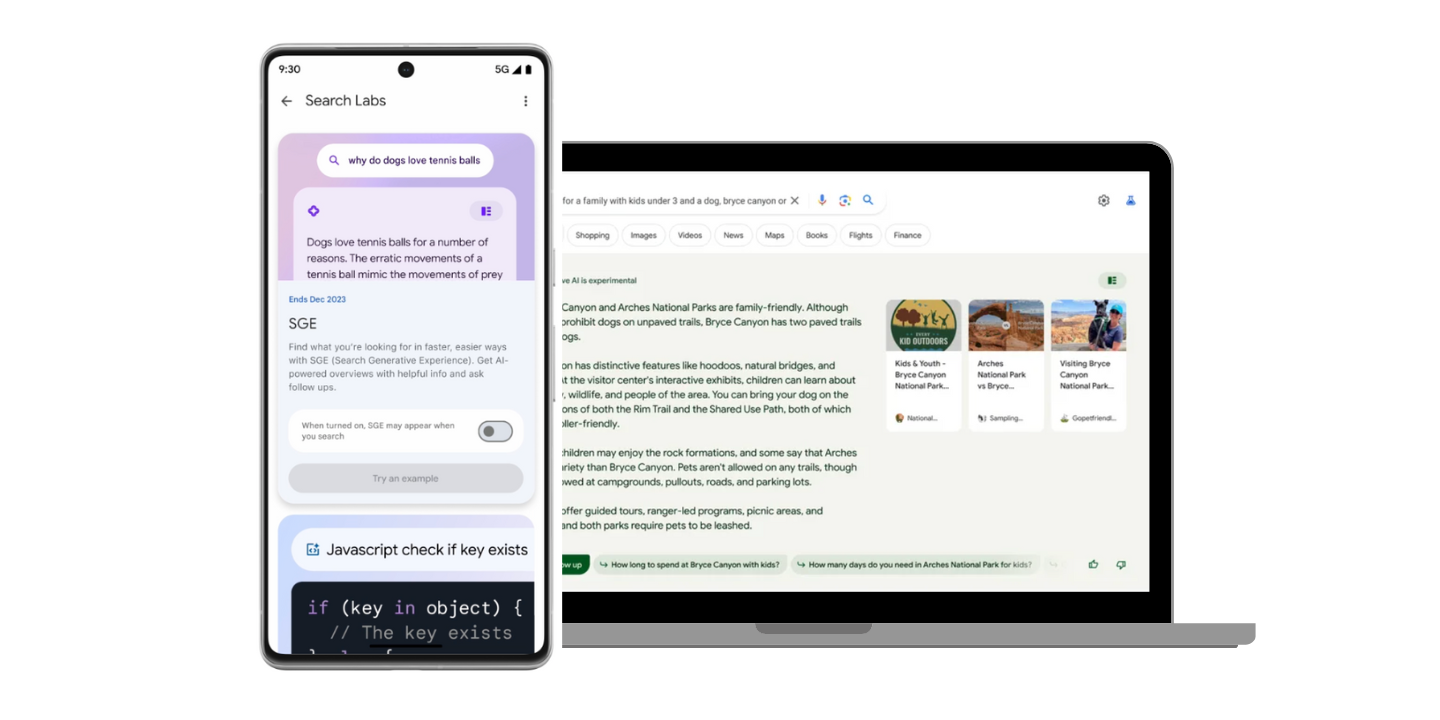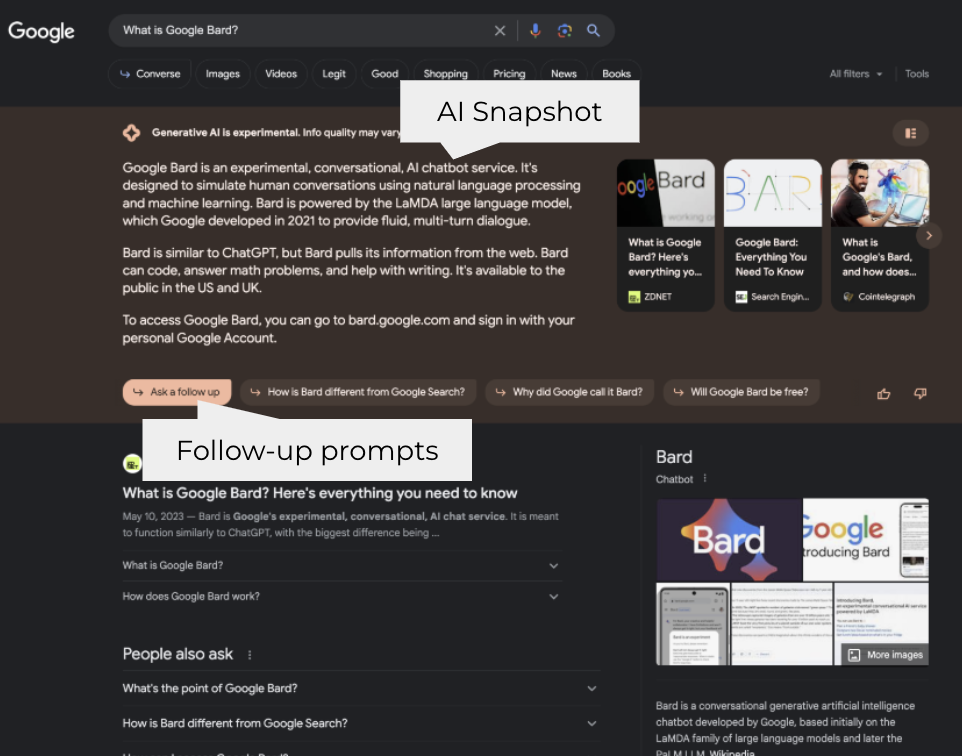

After a few months of beta testing, Google officially launched its Search Generative Experience (SGE) — now known as AI Overviews — on May 14th.
SGE is an AI-driven feature designed to enhance search results by summarizing information from multiple web pages and presenting it at the top of the search engine results pages (SERPs). The goal is to provide users with quick, comprehensive answers to their queries without needing to click through to individual web pages.
While the rollout is still pending in Switzerland, the initial launch has stirred a wave of controversy. Critics have pointed out several issues with the AI-generated answers, including inaccuracies, nonsensical information, and even potentially dangerous content. In response, Google reduced the frequency of AI-generated answers in search engine results pages (SERPs) to 15%. More updates and refinements are expected in the coming months.
How AI Overviews Work
When a user enters a query into Google’s search bar, SGE leverages AI technology to scan and summarize information from multiple web pages. The resulting text, known as an AI Snapshot, appears at the top of the search results page. Alongside the AI Snapshot, users can view selected source pages. Additionally, pre-populated follow-up prompts allow users to delve deeper into the desired topic.

Impact on Website Organic Rankings and Traffic
The introduction of SGE has raised concerns regarding its impact on organic traffic and rankings. One primary worry is the rise of zero-click searches – when users get the information they need directly from the search engine results page. Since SGE aims to provide comprehensive answers directly within the search results, users may be less inclined to click on the actual web pages that provide this information.
Another concern is the significant amount of space the AI Snapshot occupies on the SERP, making it even more crucial for websites to achieve the highest possible positions for their target keywords.
However, SGE also presents new opportunities for organic growth. For instance, a web page can appear in the AI Snapshot even if it doesn’t rank highly for the target keyword in the regular SERP. According to data from BrightEdge, the healthcare and e-commerce sectors are the most affected by queries included in SGE.
How to Prepare and Maximise the Benefits of SGE
To navigate the changing landscape and make the most out of SGE, here are some key strategies:
Understand User Intent
User intent, also known as search intent, refers to the underlying goal or motivation behind a user’s search query. It is the reason why a user conducts a particular search and what they hope to achieve with their search results. Understanding user intent is crucial for creating content that meets the needs of your audience and for optimizing your website for search engines.
In terms of SGE, Content should not only address the direct query but also the broader context within which it is asked. For example, content around financial advice should explore various user scenarios such as saving for retirement, managing student loans, investing in the stock market, buying a first home, and planning for unexpected expenses.
Optimise for EEAT: Experience, Expertise, Authoritativeness, and Trustworthiness
By focusing on EEAT, you can create content that ranks well in search engines and builds lasting trust and credibility with your audience, aligning with Google’s goals for SGE and ensuring users receive the highest quality information.
To optimize for Experience, it’s essential to highlight real-world experiences through case studies, personal stories, and testimonials. Engaging multimedia content such as videos and infographics can further demonstrate practical knowledge.
Expertise can be showcased by having content created or reviewed by qualified individuals, offering detailed and in-depth information, and regularly updating content to reflect the latest insights.
Authoritativeness can be built by citing reputable sources, showcasing industry recognition, and collaborating with recognized experts.
Trustworthiness is enhanced through transparency about qualifications and mission, ensuring accuracy and honesty, prioritizing user privacy and security, and providing a positive user experience with a clean design and easy navigation.
Implementing EEAT in your content strategy involves creating well-researched, accurately referenced content written by qualified individuals, and maintaining a rigorous content review process to ensure high standards. Regular updates to old content and the use of detailed author bios help maintain expertise and authority. Engaging with your audience through comments and feedback fosters trust and loyalty. Additionally, using trust signals like badges, certifications, and secure payment icons reassures users about the legitimacy and safety of your site.
Optimise for SGE Suggestions
To maximise the benefits of SGE, it’s crucial to optimise your content for the questions and topics that appear in AI Snapshots.
Begin by analysing the common questions and follow-up prompts related to your target keywords. This can be achieved using keyword research tools and examining the AI Snapshots for your industry. Once you have identified these questions, ensure your content directly addresses them in a clear, concise manner. Structuring your content with well-defined headings, bullet points, and concise answers makes it easier for Google’s AI to extract relevant information. Additionally, incorporating related queries and providing comprehensive answers helps cover a broader spectrum of user intent, increasing the chances of your content being featured in AI Snapshots.
Prioritise Middle and Bottom-Funnel Content
Top-of-funnel queries are now often addressed directly by AI Overviews. This makes it essential to shift focus towards middle and bottom-funnel content.
Middle-funnel content targets users who are in the consideration stage, evaluating various options before making a decision. This includes creating in-depth guides, comparison articles, and case studies that provide detailed information and help users make informed choices. By addressing the specific needs and concerns of users at this stage, you can build trust and establish your brand as an authority in your field. For example, a software company might produce detailed comparison guides between their product and competitors, or case studies showcasing successful implementations of their solutions.
Bottom-funnel content, on the other hand, is designed for users who are ready to make a purchase or take a decisive action. This type of content should focus on conversion-driven elements such as product pages, customer testimonials, detailed FAQs, and comprehensive service descriptions. Including clear calls to action (CTAs) and making it easy for users to take the next step is crucial. For instance, an e-commerce site might create detailed product pages with high-quality images, customer reviews, and easy-to-find purchase buttons. Additionally, offering special promotions, free trials, or detailed guides on how to use the product can help nudge users towards making a decision.
By prioritising middle and bottom-funnel content, you not only cater to users who are more likely to convert but also enhance the overall user journey, increasing the likelihood of achieving your business goals.
Conclusion
In conclusion, Google’s AI Overviews represent a significant shift in how search results are presented, offering both challenges and opportunities for content creators and SEO professionals. By understanding and adapting to the nuances of SGE, such as optimizing for EEAT, targeting SGE suggestions, and prioritizing middle and bottom-funnel content, you can enhance your content’s visibility and effectiveness. Emphasizing user intent and providing comprehensive, trustworthy, and relevant content will not only help you navigate the evolving landscape but also ensure you meet the needs of your audience. As SGE continues to evolve, staying agile and informed will be key to leveraging its full potential and driving organic growth.
